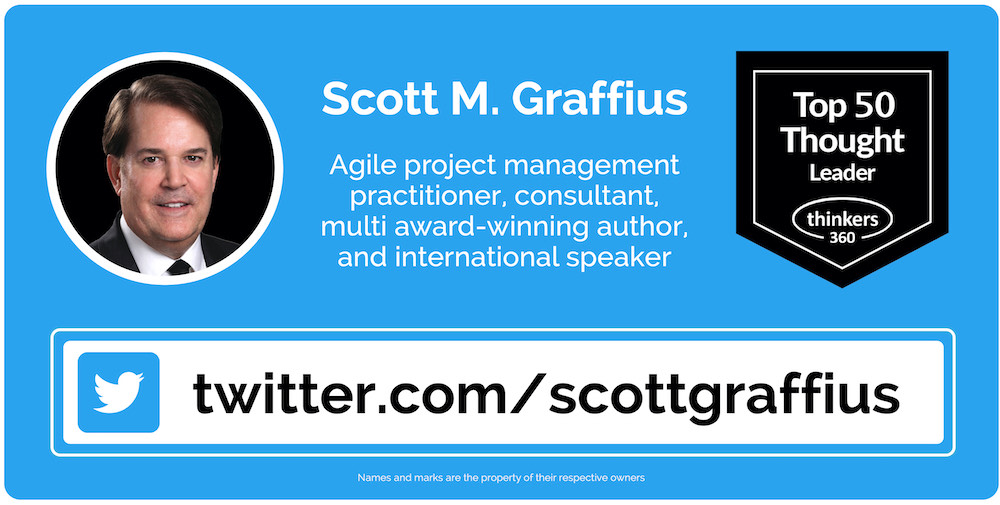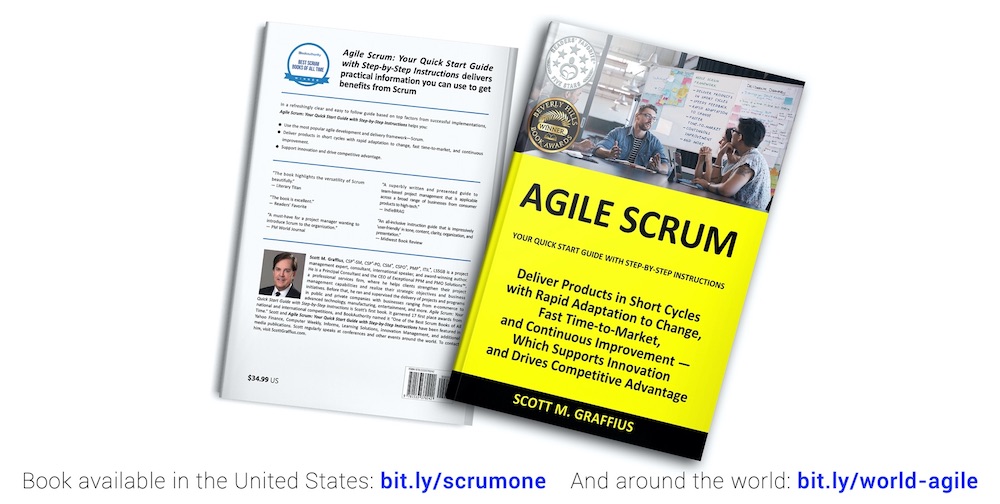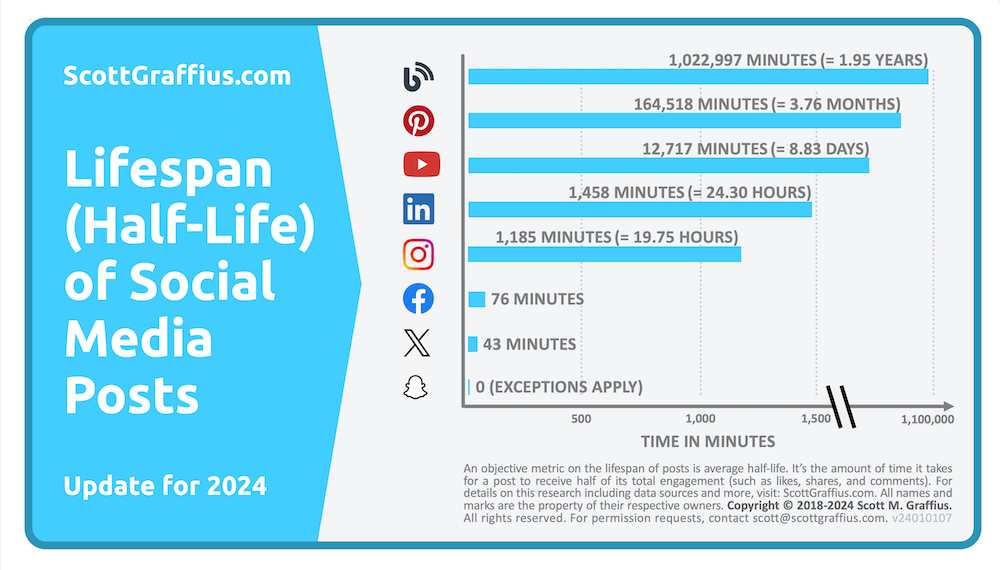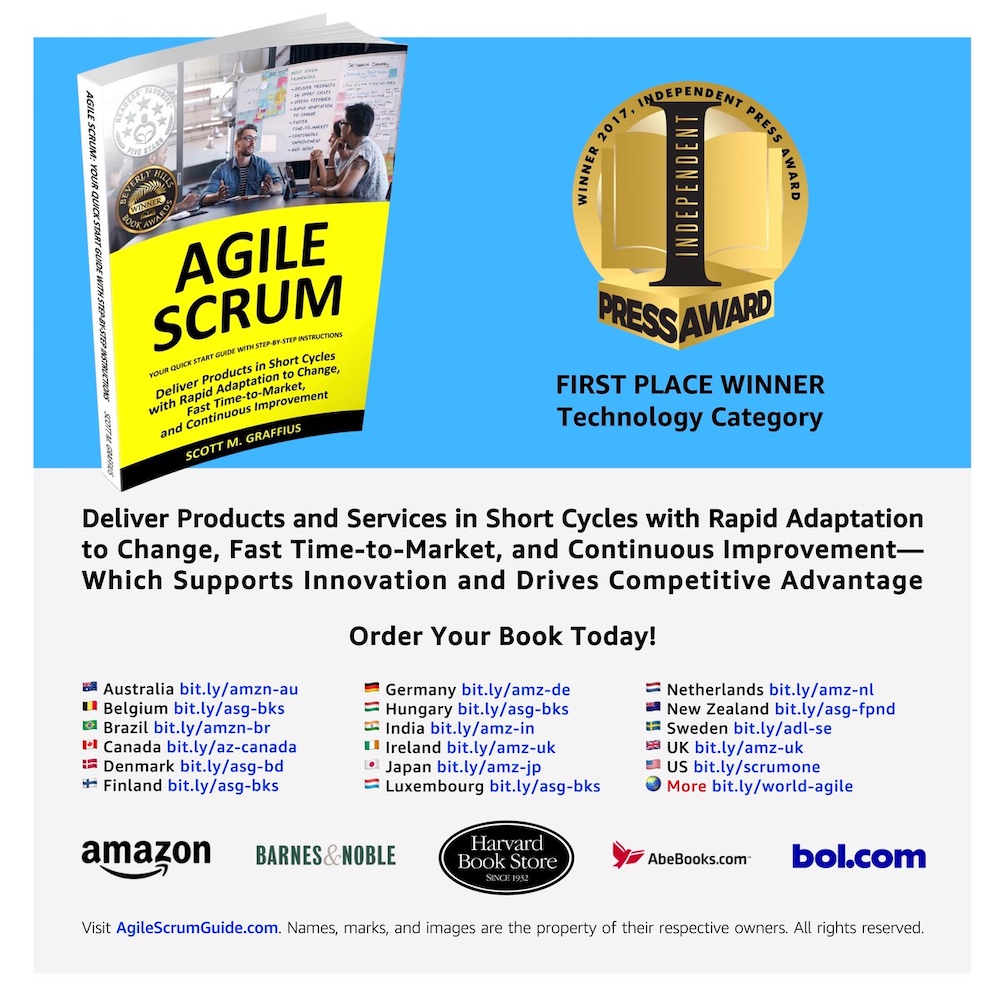#Facebook
Incorporate Minimum Viable Products (MVPs) in the Product Development Process to Improve the Probability of Launching Solutions that Meet Customers’ Needs and Succeed in the Marketplace
15 May 2023


Agile Workflows

Minimum viable products (MVPs)—coined by Frank Robinson in 2001, and subsequently popularized by Steve Blank and Eric Ries—can be advantageous tools for the development of products and services. This article is informed by Agile Scrum: Your Quick Start Guide with Step-by-Step Instructions author Scott M. Graffius' first-hand experience with MVPs as well as research and coverage from the Harvard Business Review, IEEE, MIT Sloan Management Review, Product Development and Management Association, Product School, Project Management Institute, Scaled Agile, and others (all listed in the bibliography section of this article). This article was first published at https://scottgraffius.com with the title "Leverage the Power of the Minimum Viable Product (MVP)."
Introduction

Minimum Viable Products (MVPs) can be game changers. They can be used by businesses to validate ideas, reduce time to market, and minimize risks associated with building fully featured products from the outset. This article provides those involved or interested in Agile, Lean, Product Management, Product Development, Project Management, and entrepreneurship with information on the significance of MVPs and how to leverage them.

Defining MVPs
First, it's paramount to understand what constitutes an MVP and why it matters. A Minimum Viable Product is a version of a product (or service) that incorporates just the essential features to address core customer needs and validate the viability of the concept. By employing an MVP, companies can gather valuable user feedback early on, allowing them to iterate, refine, and pivot their offering—if needed—based on market demand. This process saves time and resources, and it advances the chances of building a successful and customer-centric offering.
Here's a succinct definition of the Minimum Viable Product (MVP):
"The MVP has just those features considered sufficient for it to be of value to customers and allow for it to be shipped or sold to early adopters. Customer feedback will inform future development of the product." — Scott M. Graffius, Agile Scrum: Your Quick Start Guide with Step-by-Step Instructions
Next, examples of seven successful MVPs—Zappos, Spotify, Airbnb, Facebook, Amazon, Dropbox, and Groupon—will illustrate the power of MVPs.
MVP Success Stories
- Zappos: Zappos revolutionized the online shoe market by focusing on customer-centricity and rapid experimentation. Their MVP allowed them to validate their hypothesis, gather customer feedback, and iterate their offering to create a seamless and personalized shopping experience. Zappos is a prime example of the power of MVPs.
- Spotify: Global music streaming platform Spotify started as a simple streaming service MVP and they and continuously improved and expanded it based on customer feedback. By iterating their product, Spotify became a household name. Their MVP-driven approach ensured a product-market fit and helped them stay ahead in a competitive industry.
- Airbnb: Airbnb's success story speaks to the effectiveness of MVPs in validating an idea and subsequently scaling it to a global marketplace. Airbnb's founders started by testing their marketplace concept using an MVP strategy. By leveraging existing resources and validating demand through early adopters, they gained critical insights that shaped their platform's evolution. Today, Airbnb is a household name, offering unique accommodations worldwide.
- Facebook: Facebook's journey from a simple MVP to the world's largest social network demonstrates the power of incremental growth and user feedback. Mark Zuckerberg and fellow Harvard College students and roommates Eduardo Saverin, Andrew McCollum, Dustin Moskovitz, and Chris Hughes initially created a minimal profile-based social networking MVP (initially called "Thefacebook"), focusing on connecting people at Harvard. Through continuous iterations and the addition of features based on user needs and feedback, Facebook reshaped the social media landscape, connecting billions of people globally.
- Amazon: E-commerce giant Amazon is renowned for its relentless focus on customer experience. They started with an MVP approach, catering to customers' fundamental needs related to books, and subsequently expanded into new product categories incrementally. By prioritizing customer satisfaction, Amazon established itself as a trusted and innovative marketplace, continuously raising the bar for online shopping.
- Dropbox: Dropbox, a prominent player in the cloud storage market, kick-started its journey with a basic file-syncing MVP. By offering a simple yet essential solution to the problem of file synchronization across devices, Dropbox gained traction and valuable user insights. They leveraged this feedback to iterate and improve their product, eventually becoming a leader in the highly competitive cloud storage industry.
- Groupon: Popular online deals platform Groupon employed an MVP approach by testing deal offerings on a WordPress blog. That allowed them to validate market interest and adjust their strategy based on customer responses. By embracing the importance of market validation and adaptability, Groupon transformed into a global leader, providing users with discounted offers across various categories.
Key Principles and Best Practices for MVPs
Building a successful MVP requires adhering to key principles and best practices. It involves thoughtfully determining the relatively few features and limited scope to address core customer needs. Collecting and analyzing user feedback plays a pivotal role in making informed decisions and prioritizing enhancements. By embracing an iterative mindset and focusing on the most valuable aspects of the product, businesses can create an MVP that resonates with their target audience.
Avoiding Common Pitfalls and Challenges with MVPs
While MVPs offer significant advantages, they are not without challenges. Over-engineering the product, prematurely scaling, and failing to validate crucial assumptions are common pitfalls that can hinder success. It’s vital to strike a balance between building a viable product and avoiding unnecessary complexity. By remaining adaptable and open to change, businesses can navigate these challenges and increase the chances of achieving their goals.
Validating and Iterating via Lean and Agile Approaches
The MVP is particularly well-suited for Lean and Agile approaches and environments. Lean principles emphasize continuous learning, eliminating waste, and rapid experimentation. Agile (such as Scrum, Kanban, and SAFe) involve iterative development, frequent feedback loops, and continuous improvement. Utilizing Lean/Agile can help maximize the value of MVPs and increase chances of success.
Beyond the MVP
Once an MVP proves its viability, the focus shifts to scaling and launching the product. This stage requires a broad and deep understanding of the target market, competition, and customer preferences. It involves adapting the product based on user feedback, exploring different marketing strategies, and leveraging data-driven insights. Staying agile, continuously learning, and adapting to market dynamics are crucial for sustained growth and long-term success.

Conclusion
MVPs are powerful tools for innovation and the successful development of products/services. The examples of Zappos, Spotify, Airbnb, Facebook, Amazon, Dropbox, and Groupon highlight the transformative impact of MVPs across diverse industries. By embracing the core principles, avoiding common pitfalls, and leveraging Lean and Agile approaches, businesses can unlock the full potential of their MVPs and pave the way for sustained growth, customer satisfaction, and market leadership with their offerings. Which makes MVPs game changers.

Bibliography
- Airbnb (n.d.). About Airbnb. Available at: https://news.airbnb.com/about-us.
- Blank, Steve (2020). The Startup Owner's Manual: The Step-By-Step Guide for Building a Great Company. Hoboken, New Jersey: John Wiley and Sons.
- Cagan, Marty (2012, March 7). Viable Product vs. Minimal Product. Silicon Valley Product Group (SVPG). Available at: https://www.svpg.com/viable-product-vs-minimal-product.
- CB Insights (2021, August 3). The Top 12 Reasons Startups Fail. CB Insights Research. Available at: https://www.cbinsights.com/research/report/startup-failure-reasons-top.
- Davenport, Thomas H., & Seseri, Rudina (2020, December 15). What is a Minimum Viable AI Product? MIT Sloan Management Review. Available at: https://sloanreview.mit.edu/article/what-is-a-minimum-viable-ai-product.
- Dropbox (n.d.). About the Company. Available at: https://www.dropbox.com/about.
- Furr, Nathan, & Dyer, Jeff (2014). The Innovator's Method: Bringing the Lean Start-up into Your Organization. Boston, Massachusetts: Harvard Business Review Press.
- Graffius, Scott M. (2016). Agile Scrum: Your Quick Start Guide with Step-by-Step Instructions. North Charleston, SC: CreateSpace.
- Graffius, Scott M. (2018, October 4). Agile Scrum Helps Innovators, Disruptors, and Entrepreneurs Develop and Deliver Products at Astounding Speed Which Drives Competitive Advantage [Presentation]. Talk delivered to an audience of startups and others in the entrepreneurial community at the Techstars Startup Week Conference at The Box Theater, Riverside, California, United States. Digital Object Identifier (DOI): 10.13140/RG.2.2.25009.12647. DOI link: https://dx.doi.org/10.13140/RG.2.2.25009.12647.
- Graffius, Scott M. (2021, February 27). Are You Realizing All the Benefits from Agile? [Presentation]. Talk delivered to an audience involved or interested in Technology at the Scottish Summit 2021 Technology Conference based from Glasgow, Scotland, United Kingdom. Digital Object Identifier (DOI): 10.13140/RG.2.2.17273.90728. DOI link: https://dx.doi.org/10.13140/RG.2.2.17273.90728.
- Graffius, Scott M. (2023, May 1). Fueling the Development of Innovative and Life-Changing AI Solutions [Presentation]. Talk delivered to an audience of Technology professionals (including Data Scientists, Machine Learning Engineers, Data Engineers, AI Researchers, Project Managers, Business Analysts, UX Designers, Software Developers, Cloud Architects, Data Privacy and Security Specialists, and others involved or interested in AI) at a private event in Mountain View, California, United States. Digital Object Identifier (DOI): 10.13140/RG.2.2.27956.73601. DOI link: https://dx.doi.org/10.13140/RG.2.2.27956.73601.
- Groupon (2013, July 30). The History of Groupon. Available at: https://www.groupon.com/merchant/working-with-groupon/groupon-news/the-history-of-groupon.
- Harvard Business School (2021). MVP Development. Available at: https://entrepreneurship.hbs.edu/Documents/Session%20Summary/HBSRockMVPDevelopment.pdf.
- Krishnamurthy, Rajeshwari (2021, January 29). Why is Agile Product Development Process So Popular? Product Development & Management Association (PDMA). Available at: https://community.pdma.org/knowledgehub/bok/product-innovation-process/why-is-agile-product-development-process-so-popular.
- Lenarduzzi, Valentina, & Taibi, Davide (2016, August). MVP Explained: A Systematic Mapping Study on the Definitions of Minimal Viable Product. Proceedings from the 2016 42nd Euromicro Conference on Software Engineering and Advanced Applications (SEAA): 112–119.
- Merryweather, Ellen (2023, January 9). Product-Led Growth Strategy for Product Managers. Product School. Available at: https://productschool.com/blog/product-strategy/product-led-growth-strategy.
- Meta (n.d.). About Meta. Available at: https://about.meta.com/company-info.
- Miski, A. (2014). Development of a Mobile Application Using the Lean Startup Methodology. International Journal of Scientific & Engineering Research, 5 (1): 1743-1748.
- Moogk, Dobrila R. (2012, March). Minimum Viable Product and the Importance of Experimentation in Technology Startups. Technology Innovation and Management Review. Available at: https://timreview.ca/article/535.
- Olsen, Dan (2015). The Lean Product Playbook: How to Innovate with Minimum Viable Products and Rapid Customer Feedback. Hoboken, New Jersey: John Wiley and Sons.
- Osterwalder, Alexander, & Pigneur, Yves (2010). Business Model Generation: A Handbook for Visionaries, Game Changers, and Challengers. Hoboken, New Jersey: John Wiley and Sons.
- Project Management Institute (n.d.). Minimum Business Increments (MBIs). Available at: https://www.pmi.org/disciplined-agile/da-flex-toc/minimum-business-increments.
- Putten, Alexander B. van, & MacMillan, Ian (2004, December). Making Real Options Really Work. Harvard Business Review, 82 (12): 134-141, 150.
- Ries, Eric (2011). The Lean Startup: How Today's Entrepreneurs Use Continuous Innovation to Create Radically Successful Businesses. New York, New York: Penguin Random House.
- Scaled Agile (n.d.). Applied Innovation Accounting in SAFe. Available at: https://scaledagileframework.com/guidance-applied-innovation-accounting-in-safe.
- Spotify (n.d.). About Spotify. Available at: https://newsroom.spotify.com/company-info.
- Templeton, Chuck (2014, December 9). 10 Lessons Every Entrepreneur Should Learn. Fortune. Available at: https://fortune.com/2014/12/09/10-lessons-every-entrepreneur-should-learn.
- Thomsen, Dave (2013, December 20). Why Human-Centered Design Matters. Wired. Available at: https://www.wired.com/insights/2013/12/human-centered-design-matters.
- Umbreen, J., Mirza, Muhammad Z., Ahmad, Yasir, & Naseem, Afshan. (2022, December). Assessing the Role of Minimum Viable Products in Digital Startups. Proceedings of the 2022 IEEE International Conference on Industrial Engineering and Engineering Management (IEEM): 1073-1077.
- Wikipedia (n.d.). History of Amazon. Available at: https://en.wikipedia.org/wiki/History_of_Amazon.
- Zappos (n.d.). About Zappos. Available at: https://www.zappos.com/marty/c/about-zappos.


About Scott M. Graffius

Scott M. Graffius, PMP, SA, CSP-SM, CSP-PO, CSM, CSPO, SFE, ITIL, LSSGB is an agile project management practitioner, consultant, multi-award-winning author, and international keynote speaker. He is the Founder of Exceptional PPM and PMO Solutions™ and subsidiary Exceptional Agility™. He has generated over $1.9 billion of business value in aggregate for Global Fortune 500 businesses and other organizations he has served. Graffius and content from his books (Agile Scrum: Your Quick Start Guide with Step-by-Step Instructions and Agile Transformation: A Brief Story of How an Entertainment Company Developed New Capabilities and Unlocked Business Agility to Thrive in an Era of Rapid Change), talks, workshops, and more have been featured and used by businesses, professional associations, governments, and universities. Examples include Microsoft, Oracle, Broadcom, Cisco, Gartner, Project Management Institute, IEEE, Qantas, National Academy of Sciences, United States Department of Energy, New Zealand Ministry of Education, Yale University, Tufts University, and others. He has delighted audiences with dynamic and engaging talks and workshops on agile, project management, and technology leadership at 86 conferences and other events across 25 countries. Visit https://ScottGraffius.com to learn more.
Connect with Scott on:


About Agile Scrum: Your Quick Start Guide with Step-by-Step Instructions

Shifting customer needs are common in today's marketplace. Businesses must be adaptive and responsive to change while delivering an exceptional customer experience to be competitive.
There are a variety of frameworks supporting the development of products and services, and most approaches fall into one of two broad categories: traditional or agile. Traditional practices such as waterfall engage sequential development, while agile involves iterative and incremental deliverables. Organizations are increasingly embracing agile to manage projects, and best meet their business needs of rapid response to change, fast delivery speed, and more.
With clear and easy to follow step-by-step instructions, Scott M. Graffius's award-winning Agile Scrum: Your Quick Start Guide with Step-by-Step Instructions helps the reader:
- Implement and use the most popular agile framework―Scrum;
- Deliver products in short cycles with rapid adaptation to change, fast time-to-market, and continuous improvement; and
- Support innovation and drive competitive advantage.
Hailed by Literary Titan as “the book highlights the versatility of Scrum beautifully.”
Winner of 17 first place awards.
Agile Scrum: Your Quick Start Guide with Step-by-Step Instructions is available in paperback and ebook/Kindle worldwide. Some links by country follow.
- 🇦🇺 Australia
- 🇦🇹 Austria
- 🇧🇪 Belgium
- 🇧🇷 Brazil
- 🇨🇦 Canada
- 🇨🇿 Czech Republic
- 🇩🇰 Denmark
- 🇫🇮 Finland
- 🇫🇷 France
- 🇩🇪 Germany
- 🇬🇷 Greece
- 🇭🇺 Hungary
- 🇮🇳 India
- 🇮🇪 Ireland
- 🇮🇱 Israel
- 🇮🇹 Italy
- 🇯🇵 Japan
- 🇱🇺 Luxembourg
- 🇲🇽 Mexico
- 🇳🇱 Netherlands
- 🇳🇿 New Zealand
- 🇳🇴 Norway
- 🇪🇸 Spain
- 🇸🇪 Sweden
- 🇨🇭 Switzerland
- 🇦🇪 UAE
- 🇬🇧 United Kingdom
- 🇺🇸 United States
- 🌏 More countries

About Agile Transformation: A Brief Story of How an Entertainment Company Developed New Capabilities and Unlocked Business Agility to Thrive in an Era of Rapid Change

Thriving in today's marketplace frequently depends on making a transformation to become more agile. Those successful in the transition enjoy faster delivery speed and ROI, higher satisfaction, continuous improvement, and additional benefits.
Based on actual events, Agile Transformation: A Brief Story of How an Entertainment Company Developed New Capabilities and Unlocked Business Agility to Thrive in an Era of Rapid Change provides a quick (60-90 minute) read about a successful agile transformation at a multinational entertainment and media company, told from the author's perspective as an agile coach.
The award-winning book by Scott M. Graffius is available in paperback and ebook/Kindle worldwide. Some links by country follow.
- 🇦🇺 Australia
- 🇦🇹 Austria
- 🇧🇷 Brazil
- 🇨🇦 Canada
- 🇨🇿 Czech Republic
- 🇩🇰 Denmark
- 🇫🇮 Finland
- 🇫🇷 France
- 🇩🇪 Germany
- 🇬🇷 Greece
- 🇮🇳 India
- 🇮🇪 Ireland
- 🇯🇵 Japan
- 🇱🇺 Luxembourg
- 🇲🇽 Mexico
- 🇳🇱 Netherlands
- 🇳🇿 New Zealand
- 🇪🇸 Spain
- 🇸🇪 Sweden
- 🇨🇭 Switzerland
- 🇦🇪 United Arab Emirates
- 🇬🇧 United Kingdom
- 🇺🇸 United States
- 🌏 More countries

Let's Connect

Connect with AgileScrumGuide.com on:

The short link for this article is: https://bit.ly/mvp-win
© Copyright 2023 Scott M. Graffius, AgileScrumGuide.com. All rights reserved. This material may not be published, broadcast, rewritten or redistributed without the express written permission of Scott M. Graffius/AgileScrumGuide.com.

The Agile Project Manager’s Guide to the Lifespan (Half-Life) of Social Media Posts
05 October 2024


Agile Workflows

The Agile Project Manager’s Guide to the Lifespan (Half-Life) of Social Media Posts
Note: Earlier versions of this article were published at ScottGraffius.com. Here is an example.
In the rapidly evolving and increasingly digital-centric business landscape, the lines between roles are often blurred. Today, digital marketing frequently extends beyond those in the Marketing department. This underscores the need for agile project management professionals to build and level up the digital marketing information, skills, and capabilities in their toolkit. That includes the longevity of online media, which this article covers.
When content is posted on social media networks, its relevance and engagement are fleeting. Most posts achieve half of their total engagement (such as likes, shares, and comments) soon after posting, with the remaining interaction trailing off over time. Said differently, the pattern typically forms a positively skewed unimodal distribution where peak engagement occurs early, followed by a long tail of diminishing interaction. Understanding this dynamic through the lens of half-life—the time it takes for a post to garner half its total engagement—provides an advantageous, objective strategic metric for content planning and scheduling.
Reports by others related to the longevity of social media are often outdated or based on the experience of one person, one organization, or one limited set of data. With any of those common limitations, findings can be at risk of being non-representative, inaccurate, or unreliable.
It’s important to have a large dataset from multiple sources. By amalgamating a considerable amount of data from various sources, results will more likely be appropriately representative, accurate, and reliable. This approach also provides a more complete picture and helps identify trends.
In 2018, Scott M. Graffius first published data on the average lifespan (half-life) of posts on Snapchat, X (formerly Twitter), Facebook, Instagram, LinkedIn, YouTube, Pinterest, and blogs based on a large dataset composed of multiple, diverse sources. Algorithms and other factors on platforms change over time. For that reason, Graffius periodically updates his analysis.
A visual from the current (2024) edition of his ‘Lifespan (Half-Life) of Social Media Posts’ is shown below and the details are on his website here.

As conveyed above, the average half-life varies by social media platform. Data can help inform strategic and tactical decisions such as the frequency and scheduling of posts.
To learn more about the ‘Lifespan (Half-Life) of Social Media Posts’ research, visit here.
This brief article on digital media and the lifespan (half-life) of social media posts was presented here, on AgileScrumGuide.com, because the insights and their applicability aren’t just for those working in Marketing.
Graffius' Research is Widely Featured and Used
Scientists, researchers, journalists, academics, YouTubers, podcasters, digital marketing experts, businesses, professional associations, government agencies, and others around the world have featured and used Scott M. Graffius’ ‘Lifespan (Half-Life) of Social Media Posts’ research, indicating a broad spectrum of influence and application. Here are forty-four (44) examples:
- Amevor, Ludivine (2023, June 8). ‘Si tu postes sur les réseaux, tu as dû remarquer qu'à partir d’un certain temps après ta publication, tes interactions baissent jusqu’à cesser complètement.’ [In English: ‘If you post on social media, you must have noticed that from a certain time after your post, your interactions drop until they stop completely.’] Available at: https://www.linkedin.com/posts/ludivine-amevor_socialmedia-raezseauxsociaux-communitymanager-activity-7072505037666574336-pwZq/. [Ludivine Amevor, Social Media Manager at France-based digital agency Yuri & Neil, referenced Graffius’ ‘Lifespan (Half-Life) of Social Media Posts’ research in her post.]
- Bensley, Robert J., & Brookins-Fisher, Jodi (2023, December 14). Community and Public Health Education Methods: A Practical Guide—Fifth Edition. Burlington, MA: Jones & Bartlett Learning. [The authors cover Graffius’ work in Chapter 10 (Using Social Media) and list Graffius’ work as reference number 84 on page 256. A link to the publication at Google Books is here: https://bit.ly/cphem-5.]
- Berkessel, Juergen (2021, October 27). How Evergreen Posting on Social Media for Podcasters Creates Growth. Season 1, Episode 9 of the Podcasting Strategy Show. Available at: https://polymash.com/evergreen-posting. [The podcast references Graffius’ research. Show notes include Graffius’ “Lifespan (Half-Life) of Social Media Posts” visual as well as a hyperlink to Graffius’ full report.]
- Buffer (2024, February 7). 9 Ways to Grow Your Following on X/Twitter. Available at: https://buffer.com/resources/get-more-followers-on-twitter-x/. [It has a hyperlink to Graffius’ research.]
- Burton, Taylor (2022, November 2). Social Media Marketing: Leveraging LinkedIn. Pennsylvania Bar Institute. Available at: https://go.pbi.org/blog/social-media-marketing-leveraging-linkedin. [In the article, “LinkedIn posts are shown to have a longer lifespan” is hyperlinked to Graffius’ research.]
- Center for Direct Marketing (2024, March 25). Best Marketing Podcasts, Lifespan of Social Media and Blog Posts. Available at: https://dmcenter.com/march-2024/. [The article references, and has a link to, Graffius’ research.]
- Center for Direct Marketing (2022, September 27). What Is the Average Lifespan of a Blog or Social Media Post? Available at: https://dmcenter.com/lifespan-of-a-post. [The article includes data from Graffius and a hyperlink to his research.]
- Chaturvedi, Saurabh (2024, September 27). How Often to Post on Social Media. Available at: https://recurpost.com/blog/how-often-to-post-on-social-media/.
- Chowdhary, Tanish (2023, March 21). 13 Best Twitter Thread Tools to Go Viral in 2023. Geekflare. Available at: https://geekflare.com/best-twitter-thread-tools. [The article includes Graffius’ “Lifespan (Half-Life) of Social Media Posts” visual and a hyperlink to Graffius’ research.]
- Confederation of European Waste-to-Energy Plants (CEWEP) (2023, June 15). The Power of Social Media and How to Use It. 10th CEWEP Waste-to-Energy Congress, 14th - 16th June 2023, Berlin. Available at: https://www.cewep.eu/congress2023presentations/ and https://www.cewep.eu/wp-content/uploads/2023/06/4.1-Monika-Michalska.pdf. [CEWEP Congress presentation slide 9 featured Graffius’ visual, representing a summary of his research findings.]
- Degraux, Xavier (2022, November 5). Quelle est la Durée d’un Post sur Twitter, Instagram, LinkedIn. Available at: https://www.xavierdegraux.be/quelle-est-la-duree-dun-post-sur-twitter-instagram-linkedin. [In his article, Xavier Degraux — a social networks and content marketing consultant based in Belgium — discussed Graffius' work and provided a hyperlink to the research. Here's the title in English: How Long is a Post on Twitter, Instagram, LinkedIn.]
- Encompass Online Marketing (2023, March 15). How Often Should You Publish New Content? Available at: https://encompassonline.ca/blog/how-often-should-you-publish-new-content. [Among other points, the article references the lifespan of tweets and has a hyperlink to Graffius’ research.]
- Fallah, Georges (2023, December 18). The Best Times to Post on Social Media. Available at: https://www.vbout.com/blog/the-best-times-to-post-on-social-media. [The article has hyperlinks to Graffius’ research.]
- Gebauer, Susanna (2022, October 25). Twitter Scheduling: How to Schedule Tweets for More Impact. Available at: https://susannagebauer.com/blog/twitter-scheduling/. [The article includes a link to Graffius' research.]
- Geyser, Werner (2023, September 20). 34 Mind-blowing Pinterest Stats for 2023. Influencer Marketing Hub. Available at: https://influencermarketinghub.com/pinterest-stats. [The article references the durations of “three months” and provides a hyperlink to Graffius’ research.]
- GoDaddy (2023, February 20). How to Do Social Media: A Guide for Small Businesses and Entrepreneurs. Available at: https://www.godaddy.com/resources/skills/how-to-do-social-media. [In discussing the lifespan of tweets, the article provides a hyperlink to Graffius’ research.]
- Gotch, Nathan (2023, December 4). How to Start an SEO Business (2024 Update). Available at: https://www.gotchseo.com/start-seo-company/. [The article includes Graffius’ “Lifespan (Half-Life) of Social Media Posts” visual and a hyperlink to Graffius’ research.]
- Hawes, C. W. (2023, January 24). Social Media Half-Life. Available at: https://www.cwhawes.com/social-media-half-life. [The article identifies Graffius’ research and has a hyperlink to it.]
- John, Vanessa (2024, September 5). Website vs. Social Media - Do You Still Need a Site in 2024? Madgicx. Available at: https://madgicx.com/blog/website-and-social-media.
- Karr, Douglas (2024, February 18). The Half-Life of Social Media Posts in 2024: Navigating Lifespan for Strategic Impact. Available at: https://martech.zone/half-life-of-a-social-media-post/.
- Lin, Yunduan, & Wang, Mengxin, & Zhang, Heng, & Zhang, Renyu, & Shen, Zuo-Jun Max (2021, June 9; revised 2023, June 28). Content Promotion for Online Content Platforms with the Diffusion Effect. SSRN. Available at: https://papers.ssrn.com/sol3/papers.cfm?abstract_id=3863104 and https://dx.doi.org/10.2139/ssrn.3863104. [The scientific paper mentions Graffius’ work, and it delineates his research in the References section.]
- McErlain-Naylor, Stuart (2022, March 24). Social Media for Academia - All You Need to Know [Video]. Available at: https://www.youtube.com/watch?v=Ka88MxZbU8o. [At timestamp 13:59 in the video, Dr. Stuart McErlain-Naylor displays a visual which summarizes the 2022 edition of Graffius’ research.]
- MeetEdgar (2023, April 2). Everything You Need to Know About Repeating Social Media Content. Available at: https://meetedgar.com/blog/repeating-social-media-content. [This article from social media management tool company MeetEdgar discusses the lifespan of posts and it has a hyperlink to Graffius’ research.]
- Memom, Alafiya (2023, June 14). Master the Art of Using Pinterest for Blogging in 2023. ContentStudio. Available at: https://blog.contentstudio.io/pinterest-for-blogging. [The article rounds up the half-life of Pinterest pins as “4 months” and it includes a hyperlink to Graffius’ research.]
- Metricool (2023, October 31). YouTube Marketing in 2023. Available at: https://metricool.com/youtube-marketing. [The article includes “According to Scott Graffius’s data ...” and a hyperlink to Graffius’ research.]
- Patel, Neil (2023, May 23). 18 Powerful Twitter Marketing Tips [That Actually Work]. Neil Patel. Available at: https://neilpatel.com/blog/twitter-marketing-tips. [In the article, “The average lifespan of one tweet” has a hyperlink to Graffius’ research.]
- Pinterest Inc. (2024, October 2). Unlock The Full Potential of Pinterest with Marketing Mix Modelling. The Pinterest Inc. Business Blog. Available at: https://business.pinterest.com/en-gb/blog/unlock-potential-pinterest-marketing-mix-modelling/ and other locations. [Navigate to the Footnotes section at the end of the article, and select the corresponding "+" symbol to see the footnotes, which includes Graffius' work.]
- Pitzalis, Josh (2022, November 21). Finding Social Media Calendar Ideas for Twitter. Chirr App. Available at: https://getchirrapp.com/how-to/find. [The article references the half-life of a tweet and has a hyperlink to Graffius’ research.]
- Pugalia, Akash, & Lalani, Farah (2023, September 29). Digital Safety: How a Multi-Faceted Approach Can Help Tackle Real-World Harm. World Economic Forum. Available at: https://www.weforum.org/agenda/2023/09/digital-safety-multi-faceted-approach-tackle-real-world-harm. [The Proceedings of the National Academy of Sciences (PNAS) included data by Graffius on the half-life of social media. The World Economic Forum covered that PNAS study in their article.]
- Rainey, Clint (2023, August 15). Social Media’s Toxic Impact Can Last Up to 8 Days. This Behavioral Scientist’s Solution Might Surprise You. Available at: https://www.fastcompany.com/90939081/social-media-toxic-impact-content-moderation-solution-behavior-science. [The Proceedings of the National Academy of Sciences (PNAS) included Graffius’ research data on the half-life of social media. Fast Company covered that PNAS publication — and summarized Graffius’ data from it — in their article.]
- Rynek Pro (2023, June 26). Długość Życia Postów (Half-Life) w Mediach Społecznościowych w 2023 Roku. Available at: https://rynek.pro/half-life-dlugosc-zycia-postow/#pll_switcher. [Rynek Pro, a Poland-based advertising agency, featured Graffius’ research in their article. Here’s the title in English: Life Expectancy of Posts (Half-Life) in Social Media in 2023.]
- Sallaway Paul (2024, June 1). Using Social Media The Right Way! Available at: https://mivision.com.au/2024/06/using-social-media-the-right-way/.
- Schaffer, Neal (2024, September 17). Maximizing LinkedIn for Business Growth: A Practical Guide to Building Your Brand and Driving Results. Irvine, California. PDCA Social.
- Schneider, Philipp J., & Rizoiu, Marian-Andrei (2023, August 22). The Effectiveness of Moderating Harmful Online Content. Proceedings of the National Academy of Sciences of the United States of America, 120 (34): e2307360120. Available at: https://www.pnas.org/doi/abs/10.1073/pnas.2307360120. DOI: 10.1073/pnas.2307360120. [The scientific paper references Graffius’ “Lifespan (Half-Life) of Social Media Posts” research and uses his data.]
- Small Business Development Center (2024, September 30). 10 Marketing Strategies to Grow Your Small Business [Video]. YouTube. Available at: https://www.youtube.com/watch?v=WelVAmXuxPU&t=1181s.
- Social Selling CRM (2024). Demi-vie de Vos Publications: Stratégies d’Optimisation 2024.’ (In English: Half-life of Your Publications: 2024 Optimization Strategies). Available at: https://www.socialsellingcrm.com/demi-vie-de-vos-publications-strategies-doptimisation-2024/.
- Statler, Jacob (2024, September 12). How to Schedule Social Media Posts: Best Tools and Tips. Post Planner. Available at: https://www.postplanner.com/blog/how-to-schedule-social-media-posts/. ["The lifespan of a social media post" — in green text, located towards the end of the article — links to Graffius’ research.]
- Strozyk, Kaylee (2023, November 3). 11 Tips on How to Use Pinterest for Real Estate. Fit Small Business. Available at: https://fitsmallbusiness.com/how-to-use-pinterest-for-real-estate-agents. [The article references that the half-life of Pinterest pins is “about 3.75 months.” Selecting the respective hyperlink brings up Graffius’ research.]
- Thailand TV News (2022, August 16). Half-Life of Each Social Media Post. Available at: https://thailandtv.news/half-life-of-each-social-media-post-thumbsup. [The article incorporates data from Graffius’ work, and it has a hyperlink to his research.]
- The Tech Reps (2023, January 23). SEO or Social Media Marketing, Which is Better for Sales? [video]. Available at: https://www.youtube.com/watch?v=aVmQdHDXCrw. [The Tech Reps used Graffius’ “Lifespan (Half-Life) of Social Media Posts” visual as the background image in their video.]
- Two Rivers Marketing (2020, December 9). 8 Social Media Channels and Tactics to Consider Adding to Your Marketing Mix. Available at: https://www.tworiversmarketing.com/blog/8-social-media-channels-and-tactics-to-consider-adding-to-your-marketing-mix. [The article references the lifespan of posts and has a hyperlink to Graffius’ research.]
- Voz Comunicação Brazil (2022, October 6). Você Sabia que Cada Post em uma Rede Social Tem uma Vida Útil? [English: Did You Know That Every Post on a Social Network has a Lifespan?] Available at: https://www.linkedin.com/posts/voz-comunicacao_vozcom-comunicacao-marketingdigital-activity-6983886297958346753-osBt. [Voz’s post references Graffius’ research.]
- Walters, Christy (2023, May 4). How To Curate Content for LinkedIn: Handpick Your Next Post. CopyPress. Available at: https://www.copypress.com/kb/social-media-promotion/curate-content-for-linkedin. [The article discusses the lifespan of a LinkedIn post and has a hyperlink to Graffius’ research.]
- What What SEO (2024, September 5). 5 bonnes raisons de créer un compte Pinterest si tu es entrepreneuse. (In English: 5 good reasons to create a Pinterest account if you are an entrepreneur.) Available at: https://whatwhatseo.fr/creer-compte-pinterest-entreprise-avantages/. [The article incorporates Graffius’ research; to see the details, select 'Sources' located towards the end of the article.]
And many more.
References
Graffius, Scott M. (2024, September 30). Supplement to Graffius' 'Lifespan (Half-Life) of Social Media Posts' Research: Typical Engagement Distribution Pattern for Social Media Posts. Available at: https://scottgraffius.com/blog/files/distribution-pattern-for-social-media-posts.html. DOI: 10.13140/RG.2.2.15820.22402.
Graffius, Scott M. (2024, January 1). Lifespan (Half-Life) of Social Media Posts: Update for 2024. Available at: https://scottgraffius.com/blog/files/social-24.html. DOI: 10.13140/RG.2.2.21043.60965.
How to Cite This Article
Graffius, Scott M. (2024, September 30). The Agile Project Manager’s Guide to the Lifespan (Half-Life) of Social Media Posts. AgileScrumGuide.com. Available at: https://agilescrumguide.com/blog/files/agile-project-manager-guide-to-social-media.html. DOI: 10.13140/RG.2.2.34871.53924.


About Scott M. Graffius

Scott M. Graffius is a global leader in agile project management, an expert on teamwork tradecraft, an authority on temporal dynamics on social media platforms, a creator, a consultant and contractor, a trainer, a researcher, an award-winning author (Agile Scrum: Your Quick Start Guide with Step-by-Step Instructions and Agile Transformation: A Brief Story of How an Entertainment Company Developed New Capabilities and Unlocked Business Agility to Thrive in an Era of Rapid Change), and an international public speaker.
Visit ScottGraffius.com to learn more about Scott, and connect with him on:


About Agile Scrum: Your Quick Start Guide with Step-by-Step Instructions

Shifting customer needs are common in today's marketplace. Businesses must be adaptive and responsive to change while delivering an exceptional customer experience to be competitive.
There are a variety of frameworks supporting the development of products and services, and most approaches fall into one of two broad categories: traditional or agile. Traditional practices such as waterfall engage sequential development, while agile involves iterative and incremental deliverables. Organizations are increasingly embracing agile to manage projects, and best meet their business needs of rapid response to change, fast delivery speed, and more.
With clear and easy to follow step-by-step instructions, Scott M. Graffius's award-winning Agile Scrum: Your Quick Start Guide with Step-by-Step Instructions helps the reader:
- Implement and use the most popular agile framework―Scrum;
- Deliver products in short cycles with rapid adaptation to change, fast time-to-market, and continuous improvement; and
- Support innovation and drive competitive advantage.
Hailed by Literary Titan as “the book highlights the versatility of Scrum beautifully.”
Winner of 17 first place awards.
Agile Scrum: Your Quick Start Guide with Step-by-Step Instructions is available in paperback and ebook/Kindle worldwide. Some links by country follow.
- 🇦🇺 Australia
- 🇦🇹 Austria
- 🇧🇪 Belgium
- 🇧🇷 Brazil
- 🇨🇦 Canada
- 🇨🇿 Czech Republic
- 🇩🇰 Denmark
- 🇫🇮 Finland
- 🇫🇷 France
- 🇩🇪 Germany
- 🇬🇷 Greece
- 🇭🇺 Hungary
- 🇮🇳 India
- 🇮🇪 Ireland
- 🇮🇱 Israel
- 🇮🇹 Italy
- 🇯🇵 Japan
- 🇱🇺 Luxembourg
- 🇲🇽 Mexico
- 🇳🇱 Netherlands
- 🇳🇿 New Zealand
- 🇳🇴 Norway
- 🇪🇸 Spain
- 🇸🇪 Sweden
- 🇨🇭 Switzerland
- 🇦🇪 UAE
- 🇬🇧 United Kingdom
- 🇺🇸 United States
- 🌏 More countries

About Agile Transformation: A Brief Story of How an Entertainment Company Developed New Capabilities and Unlocked Business Agility to Thrive in an Era of Rapid Change

Thriving in today's marketplace frequently depends on making a transformation to become more agile. Those successful in the transition enjoy faster delivery speed and ROI, higher satisfaction, continuous improvement, and additional benefits.
Based on actual events, Agile Transformation: A Brief Story of How an Entertainment Company Developed New Capabilities and Unlocked Business Agility to Thrive in an Era of Rapid Change provides a quick (60-90 minute) read about a successful agile transformation at a multinational entertainment and media company, told from the author's perspective as an agile coach.
The award-winning book by Scott M. Graffius is available in paperback and ebook/Kindle worldwide. Some links by country follow.
- 🇦🇺 Australia
- 🇦🇹 Austria
- 🇧🇷 Brazil
- 🇨🇦 Canada
- 🇨🇿 Czech Republic
- 🇩🇰 Denmark
- 🇫🇮 Finland
- 🇫🇷 France
- 🇩🇪 Germany
- 🇬🇷 Greece
- 🇮🇳 India
- 🇮🇪 Ireland
- 🇯🇵 Japan
- 🇱🇺 Luxembourg
- 🇲🇽 Mexico
- 🇳🇱 Netherlands
- 🇳🇿 New Zealand
- 🇪🇸 Spain
- 🇸🇪 Sweden
- 🇨🇭 Switzerland
- 🇦🇪 United Arab Emirates
- 🇬🇧 United Kingdom
- 🇺🇸 United States
- 🌏 More countries

Let's Connect
Connect with AgileScrumGuide.com on:
And connect with agile project management practitioner, consultant, award-winning author, and international speaker Scott M. Graffius on:

The short link for this article is bit.ly/social4pm
© Copyright 2024 Scott M. Graffius, AgileScrumGuide.com. All rights reserved. This material may not be published, broadcast, rewritten or redistributed without the express written permission of Scott M. Graffius/AgileScrumGuide.com. .
